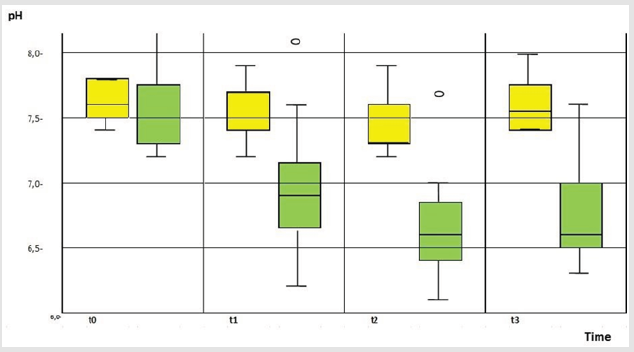Short Communication
Wound pH remains in the focus of scientific considerations for the diagnosis and treatment of chronic wounds as emphasized in recent studies [1-7]. Supported by abundant evidence, it may be taken for granted that a rapid acute wound healing occurs with low, acidic pH values at starting points below a pH value of 3. This difference in the wound environmental pH value in acute and chronic wounds has been shown to be relative to differences in the character of exudate which affects pH value [2,3,5,6]. Progress in treatment of these wounds is frequently accompanied by reduction in pH. Restarting the reparative processes is associated to acidic pH levels (e.g., 6.5) [6]. Due to the availability of commercial pH and temperature measurement devices, a real-time bedside monitoring is now feasible without prior calibration, directly inside the wound without extraction of exudate and in coincidence of pH and temperature measurement in approximately 20-30 seconds. Topic as well as systemic factors can influence the microenvironment inside wounds. There is only a limited availability of data about the relationship between microcirculation and wound pH [7]. Hence, we have collected the/our first own data about the influence of intermittent pneumatic compression (IPC) using impulse technology (intermittent impulse compression, IIC) on wound temperature and pH in venous leg ulcerations (VLU).
Materials and Methods
Parallel to a running study, we started the measurement of pH and temperature inside VLU with (n=11) and without (n=5) using IIC (Vadoplex, Oped, Valley, Germany) over a time of two hours with continuous compression application. Patients were immobilized for this period with moderate elevation of the legs and application of intermittent impulse compression using foot cuffs (f=3/min; pressure application time [single impulse] tAppl= 1 sec) for the treatment group and without additional application of compression for control group. Measurement has taken place at the start (t0), after 30 min (t1), 60 min (t2) and finally after 120 min (t3) by using the/a wound pH-meter (pH-meter TR 26, NAWA Technology, Nuremberg, Germany). In the meantime, wounds were covered by application of a temporary gauze dressing wetted by a neutral, non-buffered solution (NaCl 0.9%).
Results
We measured 59 pH values and wound temperatures in 11 patients with chronic wounds of venous origin, detecting pH values from 6.1 to 8.2 and temperature values between 27.2°C and 33.4°C at t0. Over a period of 120 minutes, individual pH-values varied up to 1.3 units and temperature values up to 2,0 degrees. In the IIC group, the mean pH value changed from 7.55 (7.2-8.2) at baseline (t0) to 6.75 (6.3-7.2) after a treatment period of 120 minutes (T-Test p=0,000). Wound temperature changed from 29.73°C (28.0- 31.6) at baseline to 30.07°C (27.7°C-31.0°C) after 120 minutes, respectively (Student’s T-test, p=0,212). In the control group, the mean pH value changed from 7.62 (7.4-7.8) at baseline to 7.63 (7.4- 8.0) at time point t3 (T-test p=0,789). Wound temperature changed from 30.72°C (28.3-33.1) at baseline to 31.30°C (29.9°C-33.0°C) after 120 minutes (T-test p=0,389). Provided that pH value of 6.5 supports the restarting of reparative processes without too much uncertainty, the mean pH value of the IPC-group after 120 minutes reaches the target pH-level more distinctively (unpaired T-test, test-level 6.5, p=0.089) than the mean pH value of the controlgroup (unpaired T-test, test-level 6.5 p=0.004). The results are demonstrated in Figure 1.
Discussion
Our data shows the influence of the application of IIC compared to no compression in patients suffering from VLU. While no significant changing in wound temperature has been observed, wound pH was strongly influenced by the application of IIC (p=0,000) and compared to control group. Without the application of compression, there is a significant difference between real wound pH and target pH value (6.5). Meanwhile the treatment group shows an impressive approximation to target pH value. These results support the suggestion that the normalization of microcirculation caused by application of IIC can modify the microenvironmental conditions inside the wound. Following the existing and established evidence that wound healing is directly linked to acidic pH levels, our results hypothesize a direct connection between IIC and restarting of reparative processes in the healing of VLU.
Declaration of Interest
The authors declare no conflict of interest.
References
- Mayuzumi J, Kikuchi N, Arai S (1980) Seasonal variations in skin temperature, skin pH, eporative water loss and skin surface lipid values on human skin. Chem Pharm Bull 28: 387-392.
- Dissemond J, Witthoff M, Brauns TC, Haberer D, Goos M (2003) Untersuchungen zum pH-Wert des Milieus chronischer Wunden im Rahmen einer modernen Wundtherapie.Hautarzt 54: 959-965.
- Glibbery A, Mani R (1992) pH in leg ulcers. J Microcirc Clin Exp 11: 109.
- Romanelli M (2003) Objective assessment during wound bed preparation. In: New concepts in wound bed preparation Falanga V [Edn.], Springer Verlag Berlin, Heidelberg, New York, 1(28): 23-34.
- Gethin G (2007) The significance of surface pH in chronic wounds. Wounds, UK. 3(3): 52-56.
- Schneider LA, Körber A, Grabbe S, Dissemond J (2007) Influence of pH on wound-healing: A new perspective for wound-therapy. Arch Derm Research 298(9): 413-420.
- Percival SL, Mc Carty S, Hunt JA, Woods EJ (2014) The effects of pH on wound healing, biofilms, and antimicrobial efficacy. Wound Repair Regen 22(2):174-186.

 Short Communication
Short Communication
